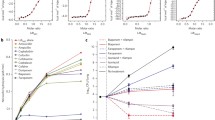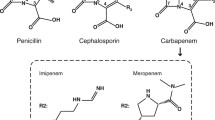Abstract
THE killing target of penicillin in bacteria is a membrane-bound transpeptidase which catalyses peptide cross linking during wall peptidoglycan synthesis1,2. Streptomyces R61 and R39 excrete during growth DD-carboxypeptidase-transpeptidase enzymes3,4 which seem to be soluble forms of the corresponding membrane-bound transpeptidases5. The exocellular enzymes (E) convert penicillin (I) in to a chemically altered and biologically inactive compound (X)6,7. Kinetically, the simplest mechanism5 for the conversion of I into X is  The first step, a rapid equilibrium process, leads to the formation of an equimolar and inactive enzyme–antibiotic complex EI. This complex isomerises into a modified complex EI* which, in turn, undergoes irreversible breakdown. If the experiment is carried out in conditions in which the enzyme is stable, the enzyme is reactivated and recovers its initial penicillin sensitivity. The breakdown of complex EI* is a slow process. At 37 °C and in 10 mM Na phosphate buffer, pH 7.0 (in which conditions the R61 enzyme is stable) the half life of the R61 enzyme–benzylpenicillin EI* complex is 80 min (ref. 7). At 37 °C and in 0.1 M Tris-HCl buffer, pH 7.7, containing 0.1 M NaCl and 0.05 M MgCl2 (in which conditions the R39 enzyme is stable), the half life of the R39 enzyme–benzylpenicillin is 4,250 min (ref. 6). As the enzyme is reactivated during the process, no enzyme is irretrievably lost on reaction with penicillin and after several cycles of inactivation and reactivation, both the enzyme and the accumulated X compound can be reisolated. This technique was applied to 14C-benzylpenicillin (benzyl labelled) and the 14C-X compound produced was isolated.
The first step, a rapid equilibrium process, leads to the formation of an equimolar and inactive enzyme–antibiotic complex EI. This complex isomerises into a modified complex EI* which, in turn, undergoes irreversible breakdown. If the experiment is carried out in conditions in which the enzyme is stable, the enzyme is reactivated and recovers its initial penicillin sensitivity. The breakdown of complex EI* is a slow process. At 37 °C and in 10 mM Na phosphate buffer, pH 7.0 (in which conditions the R61 enzyme is stable) the half life of the R61 enzyme–benzylpenicillin EI* complex is 80 min (ref. 7). At 37 °C and in 0.1 M Tris-HCl buffer, pH 7.7, containing 0.1 M NaCl and 0.05 M MgCl2 (in which conditions the R39 enzyme is stable), the half life of the R39 enzyme–benzylpenicillin is 4,250 min (ref. 6). As the enzyme is reactivated during the process, no enzyme is irretrievably lost on reaction with penicillin and after several cycles of inactivation and reactivation, both the enzyme and the accumulated X compound can be reisolated. This technique was applied to 14C-benzylpenicillin (benzyl labelled) and the 14C-X compound produced was isolated.
Similar content being viewed by others
References
Wise, E. B., Jr, and Park, J. T., Proc. natn. Acad. Sci. U.S.A., 54, 75–81 (1965).
Tipper, D. J., and Strominger, J. L., Proc. natn. Acad. Sci. U.S.A., 54, 1133–1141 (1965).
Frère, J. M., Ghuysen, J. M., Perkins, H. R., and Nieto, M., Biochem. J., 135, 463–468 (1973).
Frère, J. M., et al., Biochem. J., 143, 233–240 (1974).
Ghuysen, J. M., et al., Bull. Inst. Pasteur, 73, 101–140 (1975).
Frère, J. M., Ghuysen, J. M., Reynolds, P. E., Moreno, R., and Perkins, H. R., Biochem. J., 143, 241–249 (1974).
Frère, J. M., Leyh-Bouille, M., Ghuysen, J. M., and Perkins, H. R., Eur. J. Biochem., 50, 203–214 (1974).
Bell, M. R., Carlson, J. A., and Desterlin, R., J. org. Chem., 31, 2733–2735 (1972).
Ho, P. K., Towner, R. D., Indelicato, J. M., Spitzer, W. A., and Koppel, G. A., J. Antibiot., Tokyo, 10, 64–228 (1972).
Schmid, R., and Plapp, R., Arch. Mikrobiol., 83, 246–260 (1972).
Blumberg, P. M., Yocum, R. R., Willoughby, E., and Strominger, J. L., J. molec. Biol., 249, 6828–6835 (1974).
Author information
Authors and Affiliations
Rights and permissions
About this article
Cite this article
FRÈRE, JM., GHUYSEN, JM., DEGELAEN, J. et al. Fragmentation of benzylpenicillin after interaction with the exocellular DD-carboxypeptidase-transpeptidases of Streptomyces R61 and R39. Nature 258, 168–170 (1975). https://doi.org/10.1038/258168a0
Received:
Accepted:
Issue Date:
DOI: https://doi.org/10.1038/258168a0
- Springer Nature Limited





